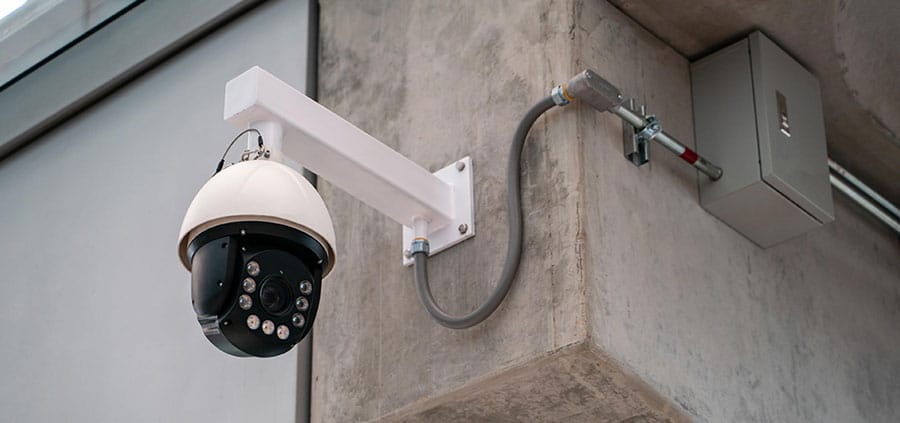Cannabis Business Video Surveillance Compliance

Are video cameras enough?
Video surveillance plays a critical role in the legal cannabis industry, serving as a cornerstone for security, compliance, and operational integrity. State and local regulations mandate strict video surveillance requirements for cannabis businesses including cultivation, processing, distribution, and retail operations. These regulations differ from state to state but often dictate the placement and coverage of videos cameras, the video resolution or quality, minimum retention period of recorded footage must be stored, and requirements for secure storage and restricted access to video footage.
Reasons for Compliance
- Maintaining License: Failure to comply with surveillance regulations can result in license revocation, effectively shutting down a business.
- Avoiding Legal Penalties: Non-compliance can lead to hefty fines and other legal penalties.
- Protecting Business Assets: Surveillance helps prevent theft and diversion, safeguarding valuable inventory and cash.
- Ensuring Public Safety: Proper surveillance helps deter criminal activity and promotes a safe environment for employees and customers.
- Building Trust and Transparency: Robust surveillance systems demonstrate a commitment to responsible operations and regulatory compliance, building trust with regulators and the public.
- Federal Considerations: Although cannabis is legal in some states, it remains illegal at the federal level creating complexities for businesses to be compliant with state regulations while navigating potential federal enforcement. Video surveillance can help demonstrate compliance with state laws and provide evidence of responsible operations.
Penalties for Non-Compliance
It's important to understand that the specific fines for video surveillance non-compliance in the legal cannabis industry can vary significantly in each state. Penalties and fines can also depend on the severity of the violations or repeat offenses by businesses that have a history of non-compliance may face harsher penalties.
Fines can range from a few thousand dollars for minor violations, such as inadequate camera coverage or insufficient video storage, to tens or hundreds of thousands of dollars for more serious offenses. Some online sources indicate that fines can range anywhere from around $5,000 for minor infractions, to upwards of $200,000 for serious violations.
License Suspension or Revocation may also be given inn severe cases. Regulatory bodies may suspend or revoke a cannabis business's operating license resulting in significant financial losses and potentially forcing the business to shut down.
Non-compliance may also lead to the seizure and destruction of non-compliant products, resulting in financial losses and supply chain disruptions. Product recalls can also be mandated, which can heavily damage a business’s reputation, and create large financial burdens.
Legal fees and related costs go beyond mere fines and can include court administrative costs and significant legal fees to defend themselves in regulatory hearings or court proceedings.
A business must also consider the cost of their operation being closed and the loss of revenue due to forced operational shutdowns.
Self-Managed Surveillance vs. IT Managed Surveillance Services
Many legal cannabis operations may look to simply installing a video surveillance system as a way to meet their compliance obligations, especially with new small start-ups. Given the level of risk and severity of not being compliant, each business should take the following points as factors to consider when making this decision.
There's a significant difference in terms of functionality, security, and ongoing management when comparing do it yourself installation and management in contrast to using professionals to install and manage your data.
Expertise and Professional Installation:
Professional IT providers have the expertise to design and implement a surveillance system that meets specific regulatory requirements and business needs. They ensure proper camera placement, network configuration, and system integration for optimal performance and minimizes blind spots and ensures reliable operation. They can also troubleshoot problems and make corrections faster than an employee of the company can.
Proactive Monitoring and Maintenance:
Surveillance compliance is more than just setting up cameras, it involves being able to securely store and manage recorded data. Most professional services offer 24/7 monitoring services, detecting potential issues before they escalate. They handle routine maintenance, including software updates, hardware repairs, and system backups to minimize downtime and ensure continuous compliance.
Secure Data Storage and Management:
IT providers typically offer secure cloud-based storage for video footage, ensuring data integrity and accessibility by implementing robust security measures to protect against unauthorized access and data breaches including managed footage retention policies and provide easy access for audits or investigations.
Network Integration and Management:
A service can integrate the surveillance system with existing network infrastructure, ensuring seamless operation and manage network bandwidth and optimize performance to prevent lag or interruptions combined with network security services to protect against cyber threats.
Scalability and Flexibility:
Many cannabis businesses outgrow their initial surveillance system as their business expends, a service can design surveillance systems that are scalable and flexible, allowing businesses to adapt to changing needs at a much lower overall cost.
Compliance and Reporting:
Cannabis IT providers are knowledgeable about regulatory requirements and can ensure that the surveillance system complies with all applicable laws. Many providers can generate detailed reports for audits or investigations, providing evidence of compliance and also provide assistance with data requests from law enforcement.
Reduced Burden on Internal Resources:
Managing a surveillance system on your own can be time-consuming and resource intensive. Outsourcing can free up internal resources to focus on core operations, eliminated the need for in house IT staff to become experts in video surveillance systems.
Advanced Features and Analytics:
Professional providers offer advanced features such as motion detection, facial recognition, and license plate recognition in addition to video analytics to identify patterns, track activity, and generate valuable insights. These features can increase the effectiveness of the system and provide data that can be used to improve business operations.

Real Benefits of a Surveillance Service
A professional video surveillance service offers significant financial and time saving benefits for legal cannabis businesses in the areas of insurance, employee theft, and law enforcement collaboration.
Insurance Costs:
Reduced Risk Profile:
Insurance companies assess risk when determining premiums. A robust, professionally managed surveillance system demonstrates a commitment to security, lowering the perceived risk of theft, vandalism, and other incidents which translates to potentially lower premiums for property, liability, and inventory insurance.
Proof of Loss:
In the event of a loss (theft, damage, etc.), clear and detailed video footage provides undeniable proof of the incident. This streamlines the claims process, reduces disputes, and helps ensure timely and accurate payouts.
Compliance with Insurance Requirements:
Some insurance providers may require specific surveillance measures as a condition of coverage. A managed service ensures that the system meets these requirements, preventing potential coverage issues.
Deterrence:
The presence of a high quality video system deters criminals and can reduce the amount of insurance claims made by the business resulting in fewer claims and lower premiums.
Reducing Employee Theft:
Active Deterrence:
Knowing that their actions are being recorded discourages employees from engaging in theft or other dishonest behavior. The transparency created by surveillance fosters a culture of accountability and reduces opportunities for internal theft.
Evidence and Investigation:
If employee theft does occur, video footage provides concrete evidence for internal investigations and potential legal action helping businesses protect their assets and maintain a secure work environment.
Inventory Control:
Surveillance systems can be integrated with inventory management systems to track product movement and identify discrepancies. This helps prevent both internal and external theft and ensures accurate inventory records.
Point-of-Sale Monitoring:
Monitoring point-of-sale transactions can reveal discrepancies, such as unauthorized discounts or cash handling irregularities, reducing employee theft and ensures accurate financial reporting.
Assisting Law Enforcement:
In the event of a robbery, employee theft or a break in a surveillance service can provide detailed information and evidence to assist law enforcement, resulting in faster response time and evidence to support convictions.
Clear and Detailed Evidence:
High-quality video footage provides valuable evidence for law enforcement investigations in the event of a break-in, robbery, or other crime by providing clear images of perpetrators, vehicle license plates, and other crucial details.
Faster Response Times:
Many studies show that Real-time monitoring and remote access to video feeds can help law enforcement respond more quickly to incidents thus increasing the chances of apprehending suspects and recovering stolen property.
Crime Scene Reconstruction:
Video footage can help law enforcement reconstruct crime scenes, providing a clear understanding of the events that transpired which is crucial for building a strong case and securing convictions.
Proactive Crime Prevention:
The simple visual presence of surveillance systems can help deter criminals from committing crimes against a business. They can also help law enforcement identify patterns and trends, allowing them to proactively address potential crime hot spots.
Considerations in Choosing a Video Surveillance Service
In writing this article we contacted Steven Arndt, President of Cannabis Technology Partners, an IT Service Provider that specializes in Cannabis Businesses, who gave us this list of considerations.
1. Camera Placement
It’s not just about having cameras—it’s about having them in the right places. Entry points, grow rooms, processing areas, and storage facilities must be covered without blind spots. Arndt recommends using a mix of camera types like fixed, dome, and pan-tilt-zoom (PTZ) cameras to ensure full visibility and regulatory compliance.
2. Backup Systems
Ask yourself: What happens if the footage is lost? Surveillance systems must have redundant backup protocols, like RAID configurations or cloud storage, to avoid data loss. Regular testing is essential to make sure those backups actually work when you need them most.
3. Privacy Compliance
Video surveillance must comply with privacy laws. Businesses should clearly define surveillance zones, avoid private areas, and use privacy filters or masking where needed. Arndt emphasizes that regulations can change frequently, making it crucial to work with an IT team that stays current.
4. Lighting Conditions
A camera is only as good as the environment it’s in. Poor lighting can render footage useless. Cameras with infrared or low-light capabilities may be needed in dim spaces, and thoughtful positioning is required to avoid glare or shadows.
5. Camera Maintenance
Too often, systems are installed and forgotten. But regular inspections and maintenance are vital. Arndt encourages a scheduled maintenance plan to clean lenses, check housing for damage, and catch issues before they impact performance.
6. Cybersecurity Protections
Surveillance systems are connected to your network—and that makes them vulnerable. Secure your system with encryption, strong passwords, segmented networks, and routine firmware updates. Proactive cybersecurity practices reduce the risk of breaches.
7. Employee Training
Employees need to understand how the surveillance system works and what to do if something goes wrong. Training should include how to review footage, export videos for investigations, and follow chain-of-custody protocols. Trust this access to your most responsible staff and plan for turnover.
8. Staying Ahead of the Curve
Surveillance requirements and technologies are evolving rapidly. Arndt advises building a scalable system that integrates with alarms, access controls, inventory tracking, and even drones. That way, your business is protected today—and ready for tomorrow.
Key Takeaways:
- The financial risks of non-compliance are substantial, and they can significantly impact a cannabis business's bottom line.
- It's crucial for cannabis businesses to prioritize compliance and invest in robust video surveillance systems that meet all applicable regulations.
- It is also very important for businesses to stay up to date on the changing laws in their area.
Many thanks to Mr. Arndt for his input and recommendations.